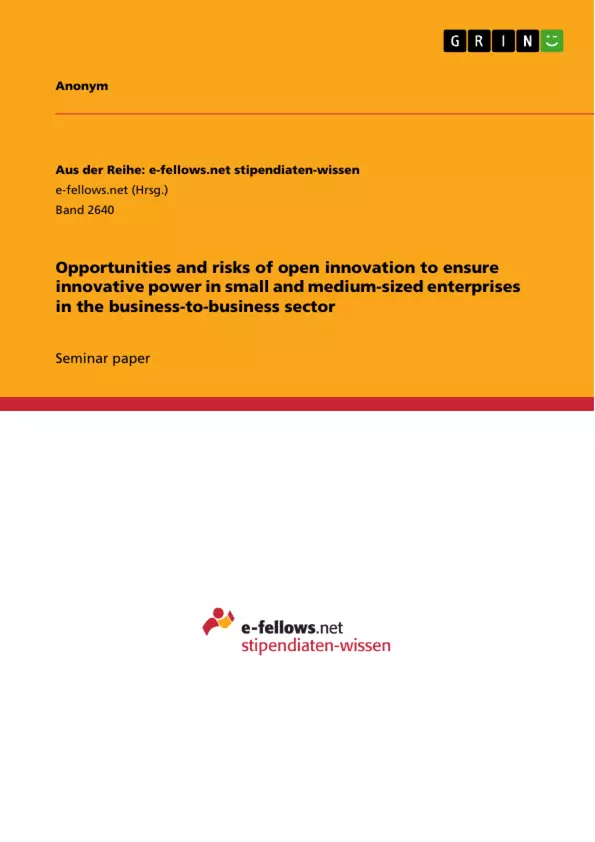In earlier days, creating innovation took mainly place behind closed doors in the R&D department of a company. However, over the course of time, globalisation opened doors to new technologies, to the global exchange of knowledge, increased the mobility of labour as well as the number of competitors in the market. The innovation environment has transformed and nowadays, ongoing innovation is a critical factor for companies to survive in the extremely competitive business environment.
When hearing innovation, many people directly think about the outcome after a creative session within a company. However, reality is slightly different and innovation appears not simply in a sudden moment and actually requires sometimes more than one party to come to a new idea. Adding more complexity to this issue, many companies struggle to afford these innovation activities on their own. Consequently, many companies make use of collaborations in form of open innovation to cope with the high pressure for ongoing innovation. Vitasek (2015) concludes that innovation and collaboration is no longer an “either-or” approach and already converged into a stabile construct over the past years. Some journals even state that ‘sharing ideas and processes side by side within the same facility is often no longer an option’ (Harvard Business Review Analytic Services, 2011).
Especially small and medium-sized enterprises (SME) with lower Research and Development (R&D) budget and less capacity for new innovations do struggle with increased complexity which is even more intense in the business-to-business (B2B) sector. SMEs must consider to reposition themselves to make strategic use of open innovation as an essential method for their survival. In this context the question arises what are opportunities and risks of open innovation for SMEs in the B2B sector and which open innovation model enhances the innovative power in SMEs most efficiently? This research question will be solved throughout the paper: First, some literature will be reviewed to create background knowledge of the constructs. Second, opportunities and risks of different open innovation mechanisms will be weighed and finally, the most efficient one(s) will be concluded.
Inhaltsverzeichnis (Table of Contents)
- Introduction
- Literature review
- Open Innovation
- Outside-in process
- Inside-out process
- Coupled process
- Innovative power in SMEs in the B2B sector
- Open Innovation
- Opportunities and risks of open innovation for SMEs in the B2B sector
- Opportunities
- Outside-in process
- Inside-out process
- Coupled process
- Risks
- Opportunities
- Conclusion
- Limitations and future research
Zielsetzung und Themenschwerpunkte (Objectives and Key Themes)
This research paper explores the opportunities and risks of open innovation for small and medium-sized enterprises (SMEs) in the business-to-business (B2B) sector. It aims to analyze the different models of open innovation and their impact on the innovative power of SMEs in the B2B sector.
- Open Innovation Models
- Opportunities for SMEs in B2B Sector
- Risks Associated with Open Innovation
- The Impact of Open Innovation on Innovative Power
- The Role of SMEs in the B2B Sector
Zusammenfassung der Kapitel (Chapter Summaries)
The introduction provides an overview of the context of open innovation and its significance for SMEs in the B2B sector. It highlights the changing innovation environment and the need for companies to embrace open innovation to survive in a highly competitive market.
Chapter 2 delves into a literature review, defining key terms and constructs crucial for understanding the topic. The chapter outlines the concept of open innovation, its different types (outside-in, inside-out, and coupled processes), and its implications for knowledge management and strategic collaboration.
Chapter 3 focuses on the opportunities and risks of open innovation for SMEs in the B2B sector. It examines the potential benefits of open innovation, including access to external knowledge, enhanced innovation capabilities, and improved customer value. This chapter also explores potential drawbacks such as information leakage, opportunistic behavior, and challenges related to managing collaborations.
Schlüsselwörter (Keywords)
The primary keywords and focus topics of this research paper include open innovation, SMEs, B2B sector, innovative power, outside-in process, inside-out process, coupled process, knowledge management, strategic collaboration, opportunities, risks, and the changing innovation environment.
- Citation du texte
- Anonym (Auteur), 2017, Opportunities and risks of open innovation to ensure innovative power in small and medium-sized enterprises in the business-to-business sector, Munich, GRIN Verlag, https://www.grin.com/document/385941



